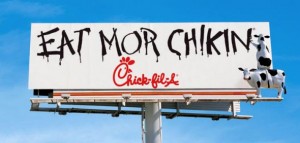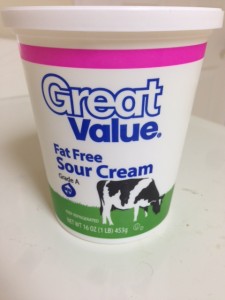This is a Billboard of two cows writing “Eat Mor Chikin” by Chick-Fil-A. This is part of Chick-Fil-A’s advertising campaign where cows are begging people to “eat more chicken” because burgers are a clear staple of most fast food places and Chick-Fil-A serves chicken exclusively. In this advertisement released by Chick-Fil-A in May of this year, a woman is eating a burger when a cow walks up to her on her park bench and watches her eat the burger, intending to imply the cow is making her feel guilty. The cow then gestures to a sign on a telephone pole that says “Lost Cow” to imply that this cow is looking for her friend and the woman is possibly eating her. While I personally find this joke to be mildly amusing and relatively harmless, if you really think about it, its also quite morbid.
The commercial is clearly anthropomorphizing the cows in order for us to sympathize with them. It’s intended to be humorous but this brings the question as to whether it is entirely ethical to make a joke out of eating chicken and beef. I am curious that if Burger King released a similar video but in place of a cow, they put a chicken, looking for her friend. Would someone feel as guilty about a chicken as they would a cow? Or because we eat both would we not care about either much? As Berger and Foer both discuss, we tend to rank the value of an animal based on their intelligence and whether or not we are “familiarized” with the animal as a companion.
So if we were to watch this commercial, do we make the assumption that the advertisers are using this value system to make us feel bad for the cow and in turn want to eat more chicken? Because clearly the chickens aren’t making a campaign for us to eat more cows. Are they as smart as the cows to start protesting chicken eating? Where are the hens confronting those chowing down on their friends by protesting it with an “Eat mor Cow” campaign? If we were faced with “Battery Cages” or “Broiler Chickens” would we still be willing to go get Chick-Fil-A?
While we accept that this is intended to be a light hearted commercial it’s interesting to me that clearly the advertisers are using what seems to be a commonly understood fact: we don’t like being confronted with what we’re truly eating. The author of Eating Animals, Johnathan Foer, discusses our imbedded guilt in “Eating Animals” in multiple ways, about the processing of meat and all that is wrong with it and why we are so uncomfortable knowing these facts. We all kind of pretend we don’t feel guilty but I’m sure that if we were confronted with a cow watching us while we ate a burger, most people would probably feel at least a small pang of guilt and maybe stop eating it until we eventually crave it again.
Foer writes:
“Perhaps in the back of our minds we already understand, without all the science I’ve discussed, that something terribly wrong is happening. Our sustenance now comes from misery. We know that if someone offers to show us a film on how our meat is produced, it will be a horror film. We perhaps know more than we care to admit, keeping it down in the dark places of our memory– disavowed. When we eat factory-farmed meat we live, literally, on tortured flesh. Increasingly, that tortured flesh is becoming our own (Foer 30) .”
I think this commercial, despite its light-hearted intentions, tugs at us a little deeper. We all recognize that we would feel guilty if a cow confronted us about eating her friend, because perhaps we know the torture that went in to making that delicious burger we’re chomping into. In America, cows aren’t typically viewed as companions but they also are generally viewed as more intelligent than a chicken, even though we still eat them. By anthropomorphizing them however, by having them look for their friends and send humans desperate pleas to not eat them, we begin to sympathize with the animal. The reason the ad-campaign has such mass-appeal is because we’re all chuckling at the fact that, as Foer says above, we all feel at least a little bit guilty about eating animals.


Recent Comments